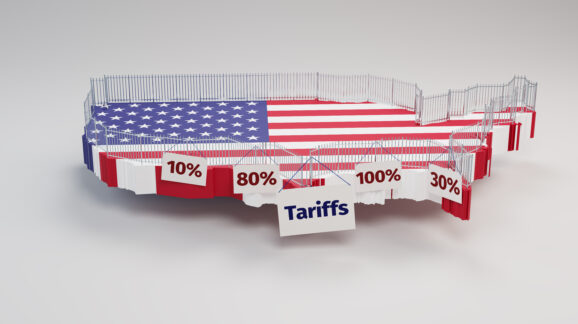Two courts, one message: Tariffs need congressional backing

Photo Credit: Getty
Within the last few days, two courts have enjoined President Trump’s tariffs under International Emergency Economic Powers Act (IEEPA) finding them unlawful. First, the US Court of International Trade ruled that the tariffs exceeded the President’s statutory authority. Then, the US District Court for the District of Columbia went further, holding that tariffs of any kind are not authorized by IEEPA.
IEEPA authorizes the president—upon declaring a national emergency of an “unusual and extraordinary threat”—to, among other powers, “regulate . . . importation . . .of . . . any property, subject to the jurisdiction of the United States.” President Trump invoked this authority to impose sweeping tariffs, claiming that imbalanced trade constituted an unusual and extraordinary threat.
The Court of International Trade (tasked under Article III of the Constitution with nationwide jurisdiction over civil actions arising out of the customs and international trade laws of the United States) focused on the power to “regulate . . . importation” and found it did not authorize the imposition of unrestricted tariffs. Much of the court’s reasoning drew from Yoshida International, Inc. v. United States (1975), a key precedent for that court. A brief detour into the history of that case will clarify its relevance.
Under the post-WWII Bretton Woods international monetary system, the United States offered to exchange dollars for gold at a ratio of 35 dollars per ounce of gold. Other countries then offered to exchange their currency for dollars, so most currency was ultimately backed by gold. In August 1971, rather than changing the exchange rate, President Nixon ended the convertibility between US Dollars and gold. This led to a massive depreciation of the dollar, and Nixon imposed wage and price controls alongside a 10 percent import tariff under IEEPA.
Yoshida International challenged the legality of the Nixon tariff imposed under the Trading with the Enemy Act. That statute was later the basis for IEEPA, which retained much of its language including the power to regulate imports. The case was decided by the precursor to the Federal Circuit (which hears appeals from the Court of International Trade) and thus is binding precedent that the court must follow until it is overturned.
In Yoshida International, the court found Nixon’s tariffs were “within the power constitutionally delegated to him.” It analyzed the statute based on what the court believed the intent of Congress was and the statute’s broad purposes.
Yoshida reflected the intentionalist approach to statutory interpretation common in the 1970s. But interpretive norms have shifted. As Justice Elena Kagan quipped, “we are all originalists now.” Courts today focus less on inferred purposes and more on the statute’s plain text.
Still Yoshida remains binding on the Court of International Trade. While that case upheld President Nixon’s tariffs, it also cautioned, quoting a concurring opinion, that “a finding that the President has the power . . . to impose whatever tariff rates he deems desirable simply by declaring a national emergency would not only render our trade agreements program nugatory, it would subvert the manifest Congressional intent to maintain control over its Constitutional powers to levy tariffs.”
Applying Yoshida to President Trump’s tariffs, the court rejected President Trump’s claim for unfettered discretion. The court agreed that the president may impose tariffs under IEEPA—but only within statutory limits. Tariff rates, it held, must align with the US Harmonized Tariff Schedule. It also examined IEEPA’s legislative history and concluded Congress did not intend to delegate open-ended tariff-setting power to the executive.
The court further rejected the administration’s claim that trade imbalances constitute an “unusual and extraordinary” threat. Congress, it noted, already addressed such concerns in 19 U.S.C. § 2132, providing a specific statutory mechanism for trade remedies. Because Congress explicitly contemplated the issue, the court reasoned, it could not qualify as unusual and extraordinary under IEEPA.
Lastly, the statute requires that executive actions “deal with” the emergency threat. That requirement led the court to strike down tariffs aimed at curbing fentanyl trafficking. The tariffs were intended not to directly stop fentanyl imports, but to pressure foreign governments to act. The court ruled that indirect measures do not meet the statutory standard. Otherwise, virtually any policy objective could be framed as a national emergency to justify tariffs—undermining the statute’s limitations.
Following the Court of International Trade’s permanent injunction on May 29, the DC district court likewise blocked enforcement. However, the DC district court is not bound to follow Yoshida. As the district court recognized, Yoshida “is no longer how courts approach statutory interpretation,” and the Supreme Court has rejected that kind of purpose-based method of interpretation. The DC district court is not bound by Yoshida and explicitly rejected its interpretive framework. “That is no longer how courts approach statutory interpretation,” it said, echoing recent Supreme Court rulings that emphasize textualism over legislative intent.
The DC district court zeroed in on the word “regulate” in IEEPA, concluding it does not encompass the imposition of tariffs. Tariffs, the court noted, are taxes—not regulations. The Constitution directly separates the power to tax and the power to regulate international trade in separate clauses. The court also quoted Chief Justice Marshall in the early foundational case of Gibbons v. Ogden that “the power to regulate commerce is . . . entirely distinct from the right to levy taxes and imposts.” The court also looked at the dictionary definition of these words and found that tariffs and regulations are not the same or subsets of each other.
In short, the DC district court found that Congress never authorized the president to impose tariffs under IEEPA. That conclusion carries broader implications than the trade court’s narrower ruling. Both decisions are subject to appeal, and legal uncertainty will persist until the issue is resolved by an appellate court, unless the Supreme Court takes review.